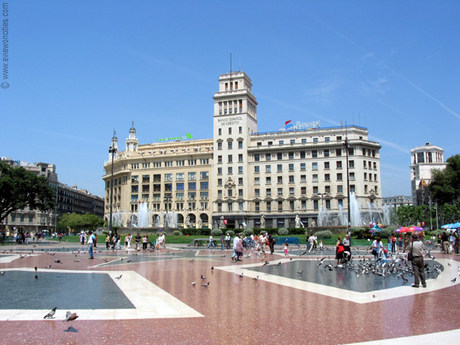Plaça de Catalunya
The Plaça de Catalunya, a large plaza surrounded by monumental buildings, is Barcelona's busiest square. It is located between the old city (Ciutat Vella) and the 19th century Eixample district. Barcelona's two most famous streets, the Rambla (a wide promenade in the old city) and the Passeig de Gracia (a grand showcase of modernist architecture in Eixample) start at the Plaça de Catalunya. Even though the square is enormous in size, it is constantly crowded with people walking to and from one of the nine streets emanating from the square.
After the medieval city walls were demolished in the 19th century, ambitious designs for the city's public spaces were conceived under the guidance of notable urban planners. Plaça Catalunya was conceived as part of pla Rovira in 1859, but no official permission from the government was given until the 1888 Universal Exposition. It was urbanized for the first time in 1902 and was further modified in 1929, on the occasion of the 1929 Barcelona International Exposition, which also included the construction of a metro station. Architect Francisco Nebot designed the changes made in 1929.
The Plaça de Catalunya also functions as a hub for the city's public transportation. Below the square is the main subway junction; three metro lines and a city railway line meet here. Many of the city's buses, as well as airport express and tourist buses stop here at the square.
Until the middle of the 19th century the Plaça de Catalunya was a rural area just outside the city walls. In 1858 the central government in Madrid finally allowed the defensive walls to be demolished. It also approved construction outside the walls so a public competition was organized for the design of a new district.
The first place was awarded to a design by Rovira i Trias, which consisted of plan with streets radiating from the historic Barri Gotic district. The central government, however, chose for a more modern design with a grid plan by Ildefons Cerdà.
The central government prevailed and the new Eixample district was designed according to Cerdà's design. Barcelona's government, however, opposed what they perceived as a lack of integration between the new and old districts. They supported Rovira i Trias's plan of a wide esplanade leading to a plaza. Cerdà's plan consisted of an extension of the Rambla towards a large square to be created on the Passeig de Gracia.
Eventually, the local and central government agreed to another plan as a compromise. The new design by the architect Puig i Cadafalch (better known for his modernist building 'Casa de les Punxes') resulted in the current enormous square, created between 1925 and 1927. Plaça de Catalunya is not integrated with any of the surrounding neighborhoods, but for a square this size is surprisingly pleasant.
The benches at the circular center of the square are ideal for people-watching. Around this centrally paved area a couple of fountains and a large number of sculptures are planted, seemingly at random. A recent addition to the square's collection of sculptures is the Monument a Francesc Macià, honoring the former president of the Generalitat (the Catalan government). The sculpture was created in 1991 by Josep Subirachs, the architect in charge of the construction of the Sagrada Familia.
At the far end is one of the largest and most prominent water fountains in the city, and a popular tourist attraction for new arrivals and long time residents alike. It is especially busy during the weekends when the city's youngsters gather to go out to the clubs.
This is the ultimate spot to meet your party, sit and relax, or stroll along the pathways of the great square to watch the street performers and visit the travelers information and souvenir kiosks. If you find larger store to your liking for shopping, some of the largest and most prominent department stores line the square. If stopping at one of the travelers kiosks is not to your liking, just below street level is hotel accommodation information bureau where the friendly staff will guide you in the right direction for any accommodation to your liking, be it a five star hotel or the nearest hostel. This area is a good location as a base for your stay in Madrid, since it is right alongside the top three museums and within walking distance of all major sights and attractions. There are plenty of hotels, self-catering apartments, and small, family-run hostels within 1km. You can get there via direct flight to Barcelona or to Girona, Reus or Lleida – Alguaire.




